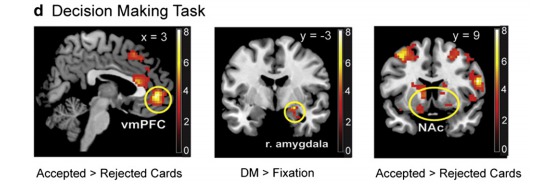 Richard Gonzalez
Richard Gonzalez
Center Director, Research Center for Group Dynamics, Institute for Social Research
Director, BioSocial Methods Collaborative, RCGD
Amos N Tversky Collegiate Professor, Psychology and Statistics, LSA
Professor of Marketing, Stephen M Ross School of Business
Professor of Integrative Systems and Design, College of Engineering
| E-mail: | Email Richard Gonzalez |
| Address: | Research Center for Group Dynamics Institute for Social Research University of Michigan 426 Thompson Street Ann Arbor, Michigan 48106 |
| Phone: | 734-647-6785 |
How do emotions help us learn and decide?

We developed a new paradigm where participants learn risky contingencies and then make decisions based on what they learned, all while in an MRI machine so BOLD can be measured along with the behavioral data. We find that affective processes play an important role in shaping subjective value in decision making as well as learning.
Ho, S., Gonzalez, R., Abelson, J. & Liberzon, I. (2012). Neurocircuits underlying cognition-emotion interaction in a social decision making context. NeuroImage, 63, 843-57. DOI:10.1016/j.neuroimage.2012.07.017 PDF
Abstract
Decision making (DM) in the context of others often entails complex cognition–emotion interaction. While the literature suggests that the ventromedial prefrontal cortex (vmPFC), striatum, and amygdala are involved in valuation-based DM and hippocampus in context processing, how these neural mechanisms subserve the integration of cognitive and emotional values in a social context remains unclear. In this study we addressed this gap by systematically manipulating cognition–emotion interaction in a social DM context, when the participants played a card game with a hypothetical opponent in a behavioral study (n=73) and a functional magnetic-resonanceimaging study (n=16). We observed that payoff-based behavioral choices were influenced by emotional values carried by face pictures and identified neurocircuits involved in cognitive valuation, emotional valuation, and concurrent cognition-emotion value integration. Specifically, while the vmPFC, amygdala, and ventral striatum were all involved in both cognitive and emotional domains of valuation, these regions played dissociable roles in social DM. The payoff-dependent responses in vmPFC and amygdala, but not ventral striatum, were moderated by the social context. Furthermore, the vmPFC, but not amygdala, not only encoded the opponent’s gains as if self’s losses, but also represented a “final common currency” during valuation-based decisions. The extent to which emotional input influenced choices was associated with the functional connectivity between the value-signaling amygdala and value integrating vmPFC, and also with the functional connectivity between the context-setting hippocampus and value-signaling amygdala and ventral striatum. These results identify brain pathways through which emotion shapes subjective values in a social DM context.


